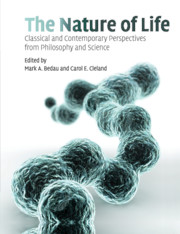Book contents
- Frontmatter
- Contents
- Preface
- Acknowledgments
- Sources
- About the authors
- Introduction
- SECTION I CLASSICAL DISCUSSIONS OF LIFE
- SECTION II THE ORIGIN AND EXTENT OF NATURAL LIFE
- SECTION III ARTIFICIAL LIFE AND SYNTHETIC BIOLOGY
- SECTION IV DEFINING AND EXPLAINING LIFE
- 23 Definitions of life
- 24 The seven pillars of life
- 25 A universal definition of life: autonomy and open-ended evolution
- 26 Does ‘life’ have a definition?
- 27 Sentient symphony
- 28 What is life?
- 29 Universal Darwinism
- 30 What is life? Was Schrödinger right?
- 31 Four puzzles about life
- Supplementary bibliography on life
- Index
- References
25 - A universal definition of life: autonomy and open-ended evolution
Published online by Cambridge University Press: 10 November 2010
- Frontmatter
- Contents
- Preface
- Acknowledgments
- Sources
- About the authors
- Introduction
- SECTION I CLASSICAL DISCUSSIONS OF LIFE
- SECTION II THE ORIGIN AND EXTENT OF NATURAL LIFE
- SECTION III ARTIFICIAL LIFE AND SYNTHETIC BIOLOGY
- SECTION IV DEFINING AND EXPLAINING LIFE
- 23 Definitions of life
- 24 The seven pillars of life
- 25 A universal definition of life: autonomy and open-ended evolution
- 26 Does ‘life’ have a definition?
- 27 Sentient symphony
- 28 What is life?
- 29 Universal Darwinism
- 30 What is life? Was Schrödinger right?
- 31 Four puzzles about life
- Supplementary bibliography on life
- Index
- References
Summary
INTRODUCTION
Definitions of life are highly controversial. And it is not just a question of lack of consensus among the different proposals formulated so far. Some authors are very skeptical about the actual possibility of grasping “in any scientifically relevant language” such a complex and multifarious phenomenon. Others think that we have to wait until biological theory(ies) become more rigorous, more encompassing and meaningful. And some others consider that it is not worth undertaking the challenge since, even if we could obtain a proper definition of life, it would still be a rather conventional one and would probably have little influence on the development of specific research programs in biology.
The living phenomenology shows, indeed, many different sides (that appear at various levels of organization) and it is not easy to capture all of them in a single conceptual scheme. This is made even more difficult by life's ability to diversify and explore its own limits (always producing border-line cases, exceptions to the rule, …). Last century's impressive advances in molecular biology have revealed a great underlying biochemical unity of all living forms, but it is not clear to what extent this is the result of contingency or of real necessity: i.e., whether that unity can serve to extract general biological principles or just derives from having a universal common ancestor of all terrestrial life.
- Type
- Chapter
- Information
- The Nature of LifeClassical and Contemporary Perspectives from Philosophy and Science, pp. 310 - 325Publisher: Cambridge University PressPrint publication year: 2010



